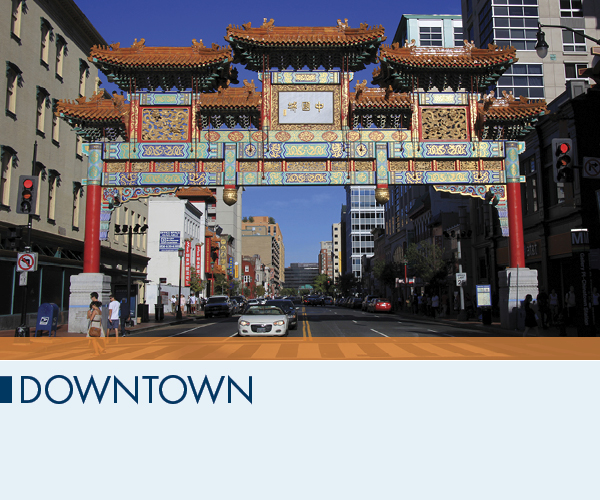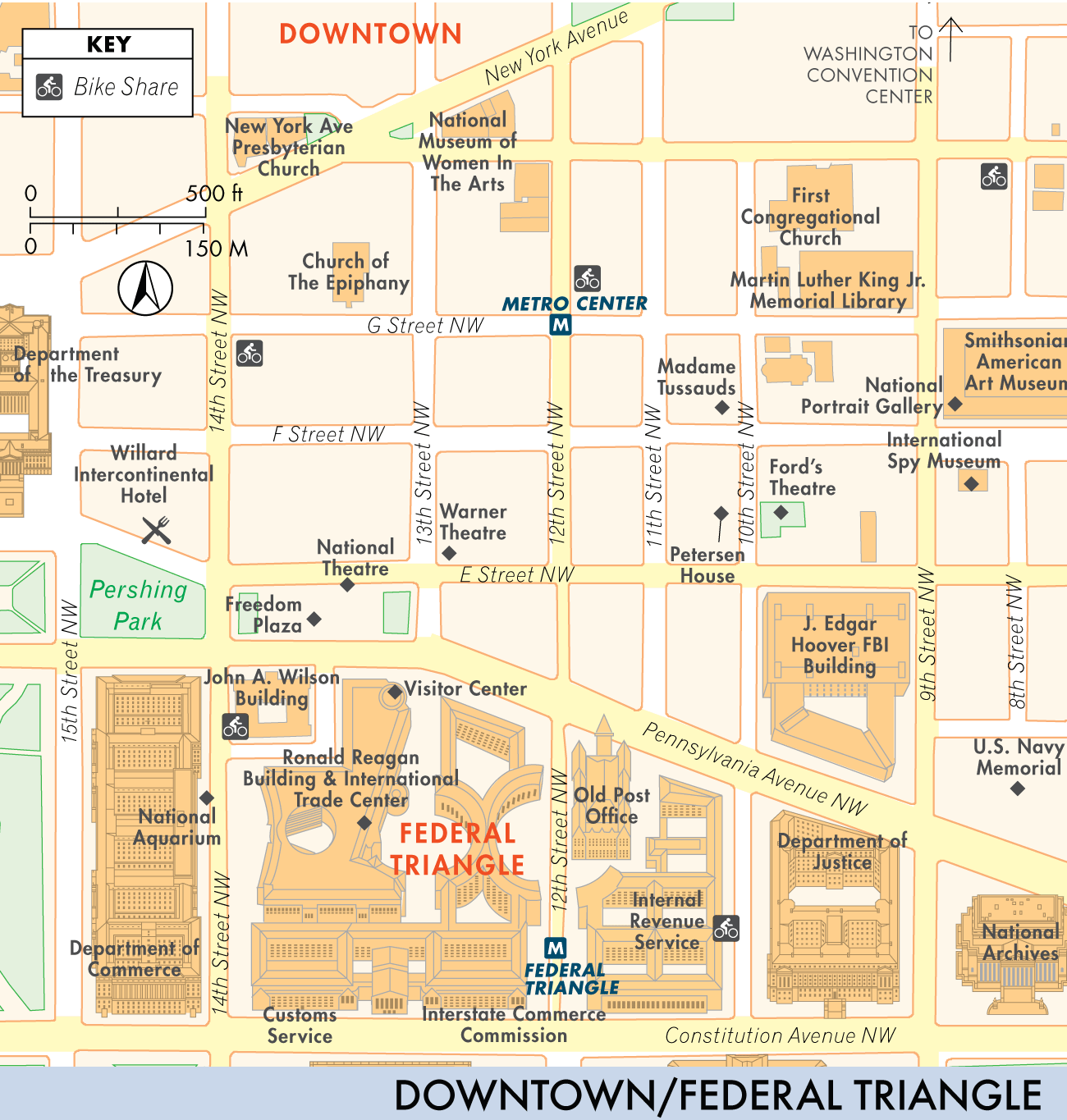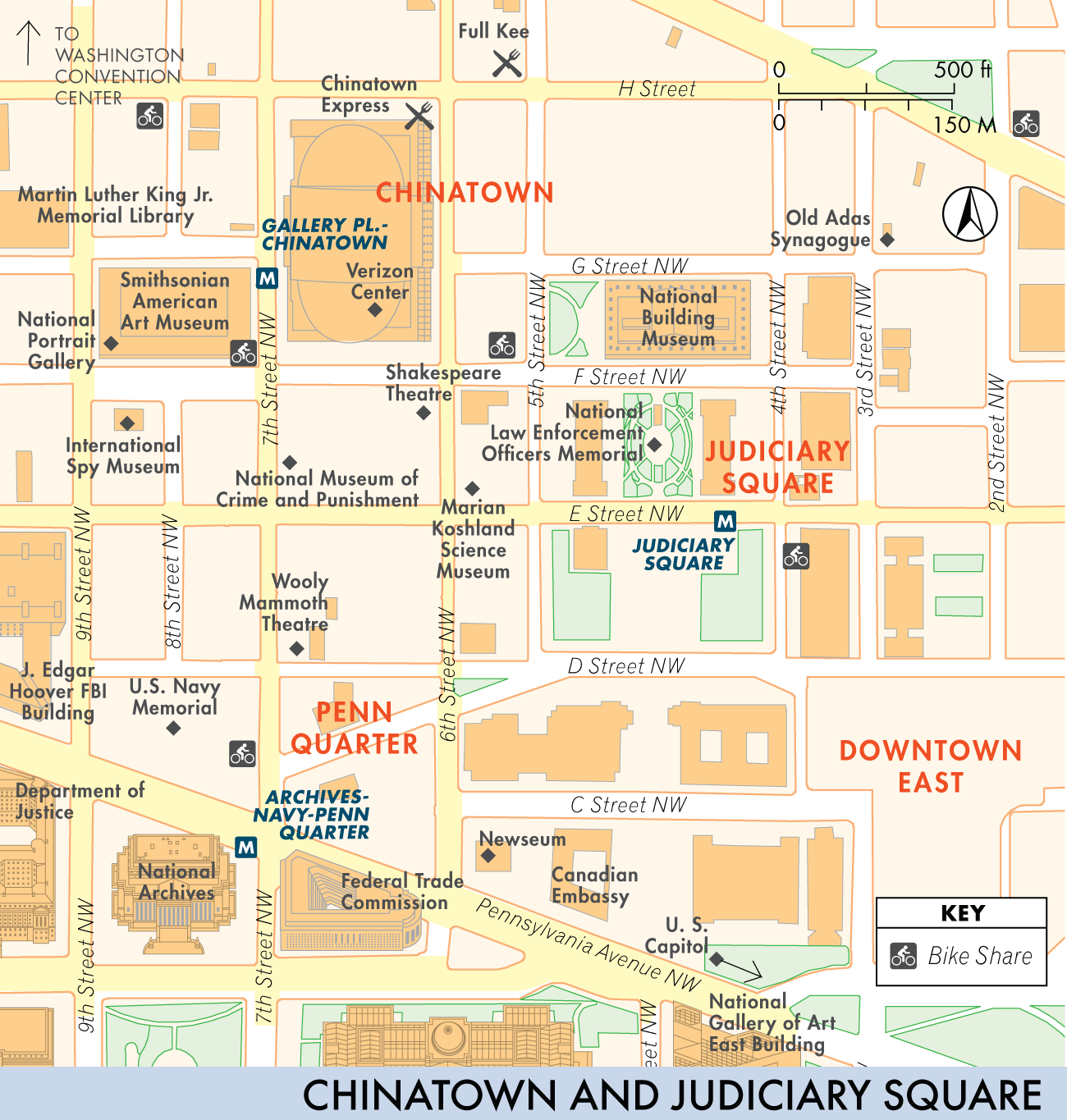
Previous Chapter | Next Chapter | Table of Contents
Getting Here | Great Experiences Downtown | Quick Bites | Planning Your Time | Nearest Public Restrooms | Safety | Downtown Walk | Downtown with Kids
Downtown D.C. is where government, commerce, and entertainment meet. The streets are wide, the buildings are as tall as they get in Washington, and it is here that D.C. feels most like a big city. It’s an extensive area, encompassing some distinct districts, and packed with historic and cultural attractions, with still more development in the pipeline. Downtown is compact; you can see the main sights in an hour and a half, not counting time spent inside museums. Travel light—you’ll have to have your bag screened before entering almost everywhere.
Getting Here
Take the Metro to Federal Triangle or Archives-Navy Memorial to visit the government buildings along Pennsylvania Avenue. The Gallery Place–Chinatown stop gives direct access to the Verizon Center, Chinatown, and the American Art and Spy museums. Judiciary Square has its own stop, and Metro Center is the best choice for the National Theatre and Penn Quarter. Bus routes crisscross the area as well. Street parking is available; it’s easier to find on nights and weekends away from the main Chinatown and Verizon Center area.
Great Experiences Downtown
International Spy Museum: Indulge your inner James Bond with a look at 007’s Aston Martin from Goldfinger—along with more serious toys used by the CIA, FBI, and KGB.
The National Archives: After seeing the Declaration of Independence, Constitution, and Bill of Rights, lose yourself in the Public Vault, where you can find everything from the Emancipation Proclamation to Mad magazine.
National Portrait Gallery and Smithsonian American Art Museum: These sister museums have something for everyone, from presidential portraits to old-timey “crazy quilts.”
Newseum: Find out how the headlines are made, and read the front pages from all over the country, displayed in front of the building.
Theater District: Catch performances, ranging from Shakespeare to the avant-garde, in Penn Quarter’s answer to Broadway.
Quick Bites
Cheap eats abound in Chinatown.
Chinatown Express.
Watch the chef stretching noodles by the window before you head into Chinatown Express to try some. | 746 6th St. NW,
Chinatown | 20001 | 202/638–0424.
Food courts.
There are food courts in Penn Quarter, eat at National Place
(1331 Pennsylvania Ave., NW 202/662–1250) and Federal Triangle at the Ronald Reagan Building (1300 Pennsylvania Ave. NW,
Downtown | 20004 | 202/312–1300).
Ming’s Restaurant.
Favorite for late-night dining with authentic, exotic Cantonese cuisine, along with Japanese and Sushi. | 617 H St. NW,
Chinatown | 20001 | 202/289–1001.
Willard Intercontinental Hotel.
The historic Willard Intercontinental Hotel serves breakfast and lunch at Café du Parc, tea in Peacock Alley, and drinks in the Round Robin & Scotch Bar. | 1401 Pennsylvania Ave. NW,
Downtown | 20004 | 202/628–9100.
Planning Your Time
Downtown is densely packed with major attractions—far too many to see in one day. You’ll need at least an hour inside each attraction, so pick the two that appeal most and stroll past the rest. Art lovers might focus on the National Portrait Gallery and Smithsonian American Art Museum; history buffs might limit themselves to touring the National Archives and the National Building Museum; families with kids may prefer the International Spy Museum; and media junkies will want to visit the Newseum and the Marian Koshland Science Museum, which looks at the science behind media headlines.
Nearest Public Restrooms
In the Federal Triangle, public restrooms are in the Old Post Office Pavilion and Ronald Reagan Building and International Trade Center. In the Penn Quarter, the free Building Museum and Smithsonian American Art Museum have bathrooms near the main entrances.
Safety
Downtown’s blocks of government and office buildings become something of a ghost town when the working day is done. You may prefer not to walk alone in this area after dark. The recently revitalized Penn Quarter still carries some vestiges of its grittier past, so stick to the main commercial areas at night.
Downtown Walk
The Downtown area can be divided into several sections, each with its own personality. Federal Triangle is the wedge-shape area south of Pennsylvania Avenue, north of Constitution Avenue, and east of 15th Street. It’s the neighborhood’s serious side, with imposing gray buildings and all-business mentality. Penn Quarter makes up the area directly to the north of Pennsylvania Avenue. This is Downtown’s party side, where restaurants and bars mix with popular museums and the burgeoning theater district. Chinatown gives the neighborhood an international flair, and Judiciary Square, immediately to the east, is like a stern older uncle frowning about the goings-on.
Federal Triangle and Judiciary Square
Begin at Metro Center, the core of D.C.’s Metro system and its busiest station; from here most of Downtown is a short walk away. Take 12th Street south to Federal Triangle. The mass of government buildings was constructed between 1929 and 1938 in order to consolidate government workers in one place, and construction continued right into the 1990s. The neighborhood was formerly known as Murder Bay for its notorious collection of rooming houses, taverns, tattoo parlors, and brothels. When city planners moved in, they chose a uniform classical architectural style for the new buildings. As you pass by, give a nod to the John A. Wilson Building, Internal Revenue Service Building, Department of Justice, and Apex Building, which houses the Federal Trade Commission. These buildings aren’t open to the public.
Ahead of you, the Ronald Reagan Building and International Trade Center houses the most secure tourist office and food court you’ll ever see. You need to show a photo ID and go through a security checkpoint in order to collect brochures and subway schedules. It’s also home to the Capitol Steps, who perform political comedy sketches on Friday and Saturday nights. The Old Post Office Pavilion, saved from demolition in 1973, has a food court and shops. The building is set to be developed into a luxury hotel by Donald Trump in 2014, but the observation deck in the clock tower—one of Washington’s best-kept secrets—will remain open to the public. Although it’s not as tall as the Washington Monument, the view from the Old Post Office’s clock tower is nearly as impressive, and it’s usually not crowded. The windows are bigger, and—unlike those at the monument—they’re open, allowing cool breezes to waft through.
Nearby, the Department of Commerce houses the National Aquarium in its basement, a location as underwhelming as the aquarium itself. Slightly hidden across the street is a tiny and delightful shady oasis, Pershing Park, a pleasant area with picnic tables and a pond. Diagonally across the street the Freedom Plaza, named in honor of Martin Luther King Jr., is often the favored site for protests and concerts, and is inlaid with a map from L’Enfant’s original 1791 plan for the Federal City. To compare L’Enfant’s vision with today’s reality, stand in the middle of the map’s Pennsylvania Avenue and look west. L’Enfant had planned an unbroken vista from the Capitol to the White House, but the Treasury Building, begun in 1836, ruined the view. Turning to the east, you can see the U.S. Capitol sitting on the former Jenkins Hill.
Follow Pennsylvania Avenue, the nation’s symbolic Main Street, known for inaugural and other parades and civic demonstrations, toward the Capitol. On your left, the J. Edgar Hoover Federal Bureau of Investigation Building has been a favorite attraction for visitors interested in espionage and the persecution of bad guys. Sadly, tours have been suspended indefinitely for security reasons, so consider the Museum of Crime and Punishment a worthy alternative. The National Archives on the right display the original Declaration of Independence, Constitution, and Bill of Rights. One of Washington’s newest and most dynamic museums, the Newseum, opened its doors in 2008. The seven-level building with 14 main galleries showcases 500 years of journalism history with multimedia displays. The spectacular stone-and-glass edifice next door is the Canadian Embassy.
Fourth Street takes you across Judiciary Square, where you will find city and federal courthouses, as well as the National Law Enforcement Officers Memorial. To the east, the small Marian Koshland Science Museum explores and explains the science behind current news headlines. Across the street the National Building Museum is known as much for its impressive interior hall as for its exhibits on architecture and the building arts. The Old Adas Israel Synagogue on 3rd Street is the oldest synagogue in D.C.
A couple of blocks to the west, new galleries, restaurants, and other cultural hot spots have taken over much of the real estate. Look out for the Shakespeare Theatre Company’s performing arts center, the Sydney Harman Hall. The area surrounding the Verizon Center sports arena has cinemas, restaurants, and shops. Expect crowds on weekend evenings. From here, you’re only a block away from the Gallery Place/Chinatown Metro stop; continue north on 7th Street to Chinatown.
Chinatown and Penn Quarter
Chinatown begins just north of the Verizon Center. This compact neighborhood is marked by the ornate, 75-foot Friendship Arch at 7th and H streets and Chinese characters on storefronts such as Ann Taylor Loft and Starbucks. Nearly every Cantonese, Szechuan, Hunan, and Mongolian restaurant has a roast duck hanging in the window, and the shops here sell Chinese food, arts and crafts, and newspapers. Nearby, Martin Luther King Jr. Memorial Library is the only D.C. building designed by the illustrious modernist architect Ludwig Mies van der Rohe. From here detour west on G Street and north on 13th Street to see the National Museum of Women in the Arts, which showcases works by female artists from the Renaissance to the present (it has the only Frida Kahlo in the city), and don’t miss its new and changing outdoor sculpture installation by women artists alongside the building on New York Avenue.
South of Chinatown, below G Street, Penn Quarter begins. This neighborhood has blossomed into one of the hottest addresses in town for nightlife and culture. The National Portrait Gallery and the Smithsonian American Art Museum are the main cultural draws. The fun and interactive International Spy Museum across the street displays the largest collection of spy artifacts in the world.
A block west along E Street brings you out to Washington’s theater district, home to the venerable Ford’s Theatre, the Warner Theatre, which has its own walk of fame on the sidewalk out front, and the National Theatre. The progressive Woolly Mammoth Theatre Company is nearby on 7th and D streets.
Tours of Ford’s Theatre, the Center for Education and Leadership, and the Petersen House take you back to the night of Lincoln’s assassination and explore the lasting legacy of his presidency. John Wilkes Booth and his coconspirators plotted out the dirty deed at Suratt Boarding House a few blocks away in Chinatown.
Downtown with Kids
If you happen to time your visit with a monthly KidSpy workshop at the International Spy Museum, your junior James Bonds and young Nancy Drews can assume a new identity complete with disguise, go on a spy mission, meet real spies, and more. This is a great museum for tweens, but younger kids may not get it.
Teens will relish the creepy interactive exhibits at the Crime and Punishment Museum.
The National Building Museum takes building blocks to new heights as kids can strap on a tool belt and design their own cities.
At the National Archives kids can gawk at the Declaration of Independence, Constitution, and Bill of Rights; suddenly school history isn’t so abstract.
The Newseum lets kids experience the stories behind the headlines, and they can even “broadcast” the news in front of the camera. Older kids can pick out big story headlines from world events they lived through.
Both the National Portrait Gallery and Smithsonian American Art Museum have something for everyone, from presidential portraits to art made from aluminum foil, bottle caps, and even television sets.
Previous Chapter | Beginning of Chapter | Next Chapter | Table of Contents

